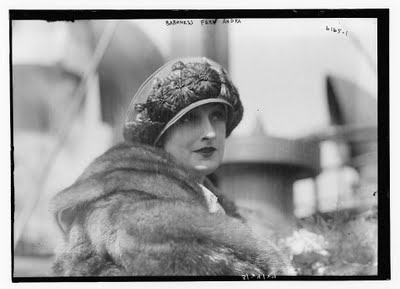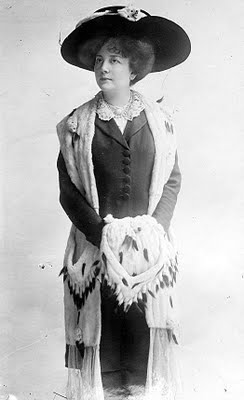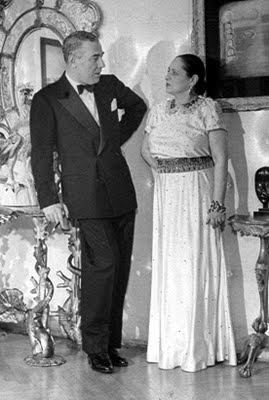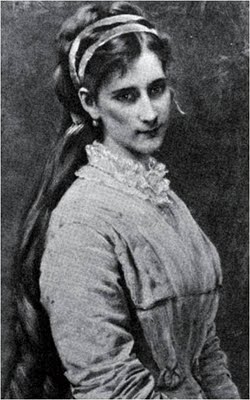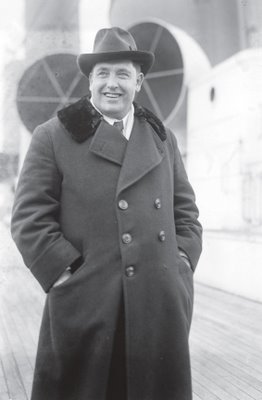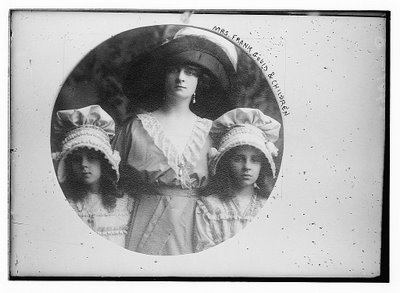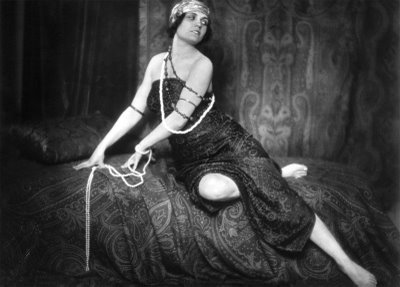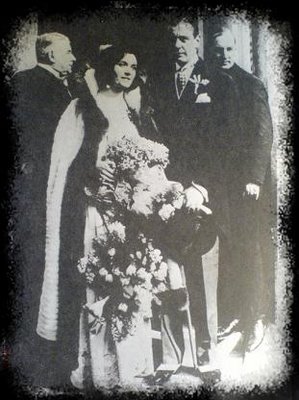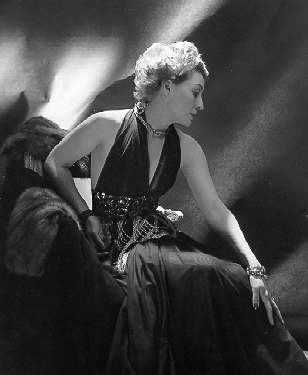

Margaret Edmona “Mona” Travis Strader, daughter of horse breeder and trainer Robert Strader and of Birdie O'Schockency Strader, was born in Louisville, Kentucky, on 5 February 1897. Her parents were divorced in 1902 and she and her brother were then reared, in an atmosphere of chaos and sadness, by their paternal grandmother. Their father tried to remain involved in his children’s lives and acquired a 76-acre estate called “Forkland,” in 1909, the same year in which he married an affluent wife. It was a lesson that was not lost on his daughter.
Mona was beautiful even as a child and developed into a stunning woman. One of her father’s clients, Henry J. Schlesinger (1879 – 1955), was 18 years older than she. His family was said to be the wealthiest in Wisconsin. He purchased Fairland Farm in Lexington in 1916 where her father bred and trained horses. On 24 January 1917, Mona married Henry Schlesinger. Her wedding gift from the groom was “a magnificent rope of pearls.” After a honeymoon trip north, the young couple moved to Milwaukee where the Schlesinger family owned an iron and coke company. They took a home there and kept Fairland Farm for annual visits. The next year, they had a son, Robert, who would cause his mother much heartache as an adult.
While living in Milwaukee Mona met the very handsome James Irving Bush (1883 – 1961) of Racine, a stellar college athlete who was described as “the handsomest man in America.” When his wife died in 1920, his relationship with Mona deepened and she divorced Schlesinger. Mona gave her husband custody of their son in exchange for a trust fund guaranteeing her between $30,000 and $50,000 per year, and she retook her maiden name.
Mona moved to New York City soon followed by Bush who was in December of 1920 named Vice President of the Equitable Trust Company. In October of 1921 she married him at New York City’s Central Presbyterian Church. He and Mona honeymooned in Havana then moved into their home at 300 Park Avenue. That marriage, too, was unhappy and it was said that her husband was an alcoholic. Mona divorced him in Paris 25 July 1925 (in 1931 Bush would marry Virginia Van Sant Alvord and in 1938 he married Ethel Post Dieterich).
Mona returned to New York City where in 1926 she opened a dress shop with a close friend, Laura Merriam Curtis, daughter of former Minnesota Governor William R. Merriam. Laura’s fiancé had been Harrison Williams (born at Avon, Ohio, on 16 March 1873), supposedly the wealthiest man in America with a fortune of $600 million. Williams left his modest bicycle business in Ohio in 1903 and moved to New York City as part of a tire manufacturing venture with his brother-in-law. His first wife, Katherine Gordon Breed of Pittsburgh, whom he married in 1900, died in 1915. In 1906 he created a gas and electric company that eventually owned many public utilities in the United States and by 1909 he was included in the Social Register. In 1923 he financed a zoological expedition to the Galapagos Islands where a volcano was named in his honor. Three years later, along with Vincent Astor and Marshall Field, he financed William Beebe’s expedition to the Sargasso Sea.
Contrary to some reports, Mona did not steal Harrison Williams from her friend. Three days after the announcement of the engagement of Laura Curtis to Harrison Williams, she abandoned him and remarried her former husband, James Freeman Curtis. Nor did Laura introduce Mona to Williams. As a friend of her first husband’s banking family in Wisconsin, he met her there and attended her second wedding in New York City.
On 2 July 1926, at Williams’ apartment on Madison Avenue, Mona Strader Schlesinger Bush married Harrison Williams. She was 29 and he was 53. In 1924 Williams had purchased the Krupp-built Vanadis, the largest yacht afloat, originally built for New York financier C. K. G. Billings (who once gave a white-tie dinner party where each guest was seated on horseback and attended by a personal liveried footman). He renamed it the Warrior and he and Mona frequently sailed around the world entertaining lavishly. It was eventually sold to Barbara Hutton in 1939 and is now a floating hotel in Stockholm.
Mona and her new husband sailed on an around-the-world honeymoon on the Warrior attended by a crew of 45. One of her acquisitions during the cruise was a 98.6-carat deep blue Sri Lankan sapphire. Upon their return Williams continued his astounding compilation of wealth, launching in 1929 two trust securities named in honor of Mona’s Kentucky heritage: Shenandoah Corporation and Blue Ridge Corporation. Only months later came the stock market crash and Williams’ net worth was reduced from $680 million to as little as $5 million. Congress accused him of having controlled one-fifth of the utilities in America. When one questioner asked why he had not been satisfied with $680 million, Williams replied, “I wanted to make it an even billion.” Shortly before the crash, one financial reporter wrote that Williams would soon be the richest man in the world. Afterwards, he would spend the remainder of his life attempting to reclaim both his reputation and his vast fortune.
Williams had for years leased J. P. Morgan’s estate at Glen Cove, but in 1926 he and Mona purchased Oak Point, a beautiful estate on Long Island, and commissioned popular architects Delano and Aldrich to design for them a palatial mansion with a fifty feet by twenty-five feet drawing room. Separately there was a sports pavilion with a tennis court and a swimming pool that hydraulically converted to a dance floor. It all added up to what photographer and designer Cecil Beaton called, “a sumptuous country house.”
In 1928 they also acquired 1130 Fifth Avenue, a beautiful home built for diplomat Willard Straight and his wife, a daughter of multi-millionaire William C. Whitney, then purchased by Elbert Gary, president of U. S. Steel. There, Mona had an all-white drawing room designed by Syrie Maugham graced by a Sorine portrait of Mona above the mantel and a stunning view of Central Park. There was also an apartment in Paris and a home in Palm Beach with 600 feet of ocean frontage, redone top-to-bottom in white by Syrie Maugham.
Mona became a constant attraction in the fashion magazines of the day. In 1936 she acquired a villa, Il Fortino, on the Isle of Capri with a stunning view of the Bay of Naples. Attached to the ocean by a private underground passage, Il Fortino boasted unequaled gardens nourished each day by a boatload of fresh water from the mainland. As one social observer wrote at the time, “The only reason the Harrison Williamses don’t live like princes is that princes can’t afford to live like the Harrison Williamses.”
The Surrealist artist Salvador Dali painted Mona’s portrait which caused widespread comment when it was exhibited in 1943. When she first saw the portrait Mona discovered she had been painted nude; she withheld payment and her figure was clothed. In the 1930’s while Mona and her husband were visiting Venice, their friend Prince Jean-Louis de Faucigny-Lucinge introduced them to an associate who had actively sought the introduction. He was Count Albrecht “Eddie” von Bismarck-Schönhausen, born at Friedrichsruh on 6 July 1903, third son of the 2nd Prince Bismarck and of Countess Marguerite Hoyos (granddaughter of Robert Whitehead, inventor of the torpedo), and a grandson of the famous Iron Chancellor. The Count proved a valuable ally and easily slipped into a position as Harrison Williams’ secretary.
Having survived the stock market crash and the succeeding Depression, the Williams were forced to make financial concessions. They sold their yacht in 1939, then sold both their Long Island estate (it was demolished in 1950) and their Palm Beach home. By 1942, they were occupying only two floors of their Fifth Avenue mansion and placed their eight cars in storage. They remained friendly with a pro-German set during the War and were suspected of pro-Nazi sentiments. Harrison Williams quietly worked to restore his fortune and, having accumulated $100 million, he died at Bayville, New York, on 10 November 1953 at the age of 80. He left $10 million to his sister, Zella, who outlived him by only six weeks. The remaining $90 million was left to Mona.
Her newly-inherited wealth did not shield her from care, however. In 1955 her son, Robert Schlesinger (who was described in contemporary news accounts as a “playboy”), fell in love with actress Linda Christian who had been discovered by dashing actor Errol Flynn and featured in the 1946 movie, “Holiday in Mexico.” In 1949 she married equally-handsome actor Tyrone Power by whom she had two daughters (one of whom, Taryn Power, followed her parents into acting and was in “Sinbad and the Eye of the Tiger” in 1977). Linda Christian and Tyrone Power divorced in 1956 and she received an unprecedented one million dollar settlement. She would become the first “Bond girl” in the screen adaptation of Ian Fleming’s “Casino Royale.” When Linda Christian first became involved with Mona’s son, she was still married to Tyrone Power.
Schlesinger began sending Linda very expensive jewelry eventually exceeding $132,500 in value. When his $100,000 check to Van Cleef & Arpels bounced, the tony jeweler sued Linda seeking return of the gifts. Mona’s son was then indicted on eight counts of using his mother’s name and reputation to swindle three prominent businessmen in an elaborate oil scheme. Schlesinger had even pretended in a telephone conversation to be his mother’s official financial advisor as the noose began tightening around his neck. In the end, Robert Schlesinger didn’t get the money or the girl. Linda Christian married British actor Edmund Purdom who starred in the 1954 movie of “The Student Prince” (he lip-synched to Mario Lanza’s voice). After that divorce she was dating the wealthy race-car driver Alfonso “Fon” de Portago, 17th Marquis of Portago ad 13th Count of Majorada, when he was killed in a 1957 crash that also killed his co-driver as well as nine spectators including five children. The Marquis had jumped out of his car just before the start of the race to kiss Linda Christian in the crowd. At the time he was still married to South Carolina beauty Carroll McDaniel by whom he had two children (by the first American super-model, Dorian Leigh, he also had a son who committed suicide at the age of 21). Carroll McDaniel would later marry Milton J. Petrie, founder of Petrie Stores, who was reportedly worth $940 million at his death and left her a trust fund of $150 million.
With her son’s legal troubles just becoming public, on 7 January 1955, Mona Williams married in a private civil ceremony at the municipal court in Edgewater, New Jersey, Count Eddie von Bismarck (they would later have a religious ceremony in Rome on 14 February 1956). She was 57 and the groom was 51. At the time, he was thought to be suffering from terminal colon cancer. The count, formerly an interior decorator (his work included the Embassy Club of the Hotel Ambassador in New York City), began dealing privately in antiques. Mona must have been aware that he was homosexual, but they enjoyed a fifteen-year companionable marriage that worked well for both of them. By some accounts, Mona may have enjoyed the chalice as well as the sword. The much-married Etti Plesch, the only woman to have won the English Derby twice, wrote in her memoirs of an engagement party given for Etti at the first of her six marriages, this one to American millionaire Clendenin Ryan, Jr., “… given by the legendary (and somewhat predatory) beauty, Mona Harrison Williams (later Countess Bismarck). She was absolutely fantastic and one of the most beautiful women I ever saw with her green eyes and red hair…. I was a bit surprised when she followed me into a room and closed the door behind her. I had to escape. I did not know she was like that.”
In 1956 the von Bismarcks bought a home in a fashionable section of Paris and had it luxuriously decorated by Stephan Boudin who would later help Jackie Kennedy at the White House. They alternated between winters in Paris and spring and summers at Capri and both converted to Catholicism. Baron Alexis de Redé recalled an elegant party at the Paris home of the Duke and Duchess of Windsor. The very wealthy Arturo Lopez-Willshaw, whose wealth was lavished both on the Baron and on the Hotel Lambert, had visited Mona’s flat there while she was away. At the Windsor party she admonished him, “How dare you, little man, go into my cupboards and look through everything!” Lopez-Willshaw was slightly inebriated and replied, “You were a manicurist! How dare you say those things to me? Your husband is nothing more than a German gigolo!” For whatever its purposes, their marriage worked well until Count Eddie von Bismarck’s death at Geneva on 16 October 1970.
Perhaps Mona was not designed for life alone, for on 6 November 1971, she married in Geneva her late husband’s doctor, Umberto de Martini. She was 74 and he was 60. Though he was multilingual (Mona spoke only English) and walked her dogs faithfully, Mona’s friends were not pleased at her most recent husband. Through her old friend, Italy’s exiled King Umberto II, Mona purchased a title for him and he was created Count Umberto de Martini on 10 January 1973. Even in their elegant French home Martini served simple pasta dishes with inexpensive wines. He dismissed her long-time employees and was alleged to keep her medicated.
On 30 June 1979, Mona’s last husband was killed when the sports car he was driving careened off a bridge near Naples and landed in the river below. Inevitably Mona’s friends referred to the accident as “Martini on the rocks.” His will made it evident that he had planned to outlive her and inherit her fortune. Having told her that he was opening a clinic, he had already pocketed $3 million in a Swiss bank account and made bequests to an embarrassing number of relatives of whom Mona was unaware. She quickly dropped his name and resumed calling herself “Countess Bismarck.”
Mona’s old friend Cecil Beaton visited her at Capri and was shocked to find that all traces of her famous beauty had left her. “She is now suddenly a wreck. Her hair, once white and crisp and a foil to her aquamarine eyes, is now a little dried frizz, and she has painted a grotesque mask on the remains of what was once such a noble-hewn face, the lips enlarged like a clown, the eyebrows penciled with thick black grease paint, the flesh down to the pale lashes coated with turquoise… Oh, my heart broke for her.” Mona spent her last years putting her affairs in order and making arrangements for various paintings to be disbursed to institutions of her choosing. On 10 July 1983, she died at her house in Paris. She was buried in a Givenchy gown with her third and fourth husbands, Harrison Williams and Count Eddie von Bismarck, at Glen Cove on Long Island. Of the $90 million she had inherited from Williams, approximately $25 million remained. She gave one million dollars to her wayward son and the balance, including the proceeds from the sale of Il Fortino as well as her famous jewels, established the Mona Bismarck Foundation still headquartered in her Paris home.
